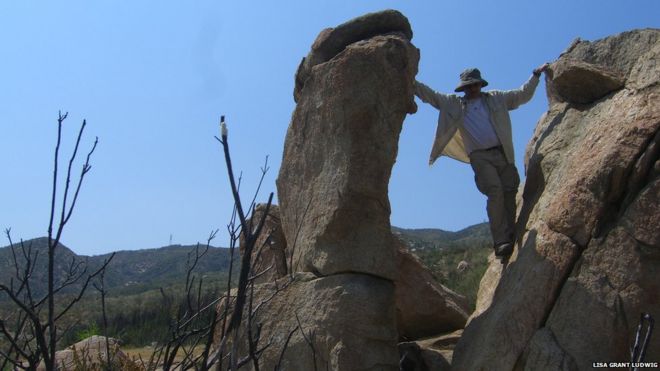Balancing rocks trace history of ‘jumping’ earthquakes

The researchers spent 10 years collecting measurements of balancing rocks
US scientists say they have solved the riddle of why a collection of balancing rocks near the San Andreas fault has never been toppled by earthquakes.
Their decade-long study concludes that quakes can stop or “jump” due to interactions between the San Andreas and the neighbouring San Jacinto fault.
Models show that these interactions sent the biggest vibrations around the rock stacks, leaving them intact.
But the connected nature of the faults has implications for quake planning.
The study of precariously balanced rocks was begun in the 1990s by Jim Brune, now an emeritus professor at the University of Nevada and a co-author of the new paper.
“He realised that [these rocks] could be a check on seismic hazard maps, and give long-term indications of ground shaking,” said the study’s lead author Prof Lisa Grant Ludwig, from the University of California, Irvine.
“They are kind of natural seismoscopes – but you have to read them indirectly.
“They don’t tell you an earthquake happened, they tell you ‘an earthquake strong enough to knock me down did not happen’.”
Tipping point
Generally, balancing rocks are not seen within 15km of major faults. But 10 years ago Prof Brune and his colleagues found two sizeable collections of such stones just 7-10km from the San Andreas and San Jacinto faults, in the San Bernardino mountains of California.
The teetering rocks sit less than 10km from two major faults
In the new study, due to be published in the journal Seismological Research Letters, these rocks were carefully catalogued and measured.
Importantly, the team calculated how much force it would take to tip each of the rocks over.
“There are two methods of doing that, one of which is actually trying to tip the thing,” Prof Ludwig said. This meant some nerve-wracking fieldwork, gently pushing the rocks until there was some movement, but not actually tipping them over.
“If my mother had known I was doing that, she would not have been happy,” Prof Ludwig confessed. “You never want to be on the downhill side when you tip it.”
The second method, for rocks too dangerous or difficult to tip, was “photomodelling”: using views from multiple angles to build a 3D model of the balanced stone and calculate its centre of gravity, mass, and so on.
Both these methods, along with some “shake table” simulation experiments, showed that the rocks should have fallen over during quakes as recent as 1812 and 1857.
The famous San Andreas fault stretches 1,300km across California
But various measures can tell us exactly how long the stones have perched in their places – and it is millennia, not centuries.
“One of my former postdocs did an age study of one of the rocks. And it’d been in that position about 18,000 years,” said Prof Ludwig.
So how did these precarious rocks withstand the tens or hundreds of earthquakes that shook the region during that time?
Network of fractures
“The inescapable conclusion was that the ground motions had to be lower than you would expect from typical earthquakes on the San Andreas and San Jacinto faults,” Prof Ludwig explained.
The team’s best explanation for that surprisingly small ground movement – and one supported by computer modelling of big earthquakes – is an interaction between the two faults.
Precarious rocks, like this one in Nevada, can act as natural measures of earthquake strength over time
Precarious rocks, like this one in Nevada, can act as natural measures of earthquake strength over time
“The San Andreas and San Jacinto faults come very close together; they’re only about 2km apart. And it’s been well established, through other earthquakes and modelling studies, that a rupture can jump across [a gap like that]. It’s what’s called a stepover.
“What if the rupture jumped across, or alternatively, stopped at this junction, or started at this junction? All three of those cases would produce lower ground shaking in the area where we found the rocks.”
It is crucial to consider the faults together, Prof Ludwig said – not just to explain the baffling, balancing rocks, but also in order to plan safely for future earthquakes.
“These are really networks of fractures in the earth. Just because we give them different names doesn’t mean that they behave independently.”
Shaky scenario
Dr Lucy Jones is a long-serving seismologist and a science adviser for risk reduction at the US Geological Survey. She said the paper would have “pretty significant implications” for earthquake planning in California.
In particular, Dr Jones said the findings might impact the “ShakeOut scenario” – in which she and others modelled a major San Andreas quake, to support safety drills and procedures.
“I think that this study actually makes the particular ShakeOut scenario less likely, but I’m not sure it means that we’re definitely going to get less ground motion,” Dr Jones told the BBC.
“It isn’t a clear-cut answer as to whether we’ll be better off or worse off. We’re going to need time to look at the permutations.”
Looking beyond individual quakes, Dr Jones said the new study fits into a “pretty well accepted picture” that in the long-term, seismic activity is gradually shifting from the southern stretch of the San Andreas fault across to the younger San Jacinto fault.
“This study is a really cool piece of evidence that maybe the jump is a little further along than we assumed,” she said.
Did you know that pets can often detect ear quakes before they happen? Here’s a story from Animal X about some such pets.